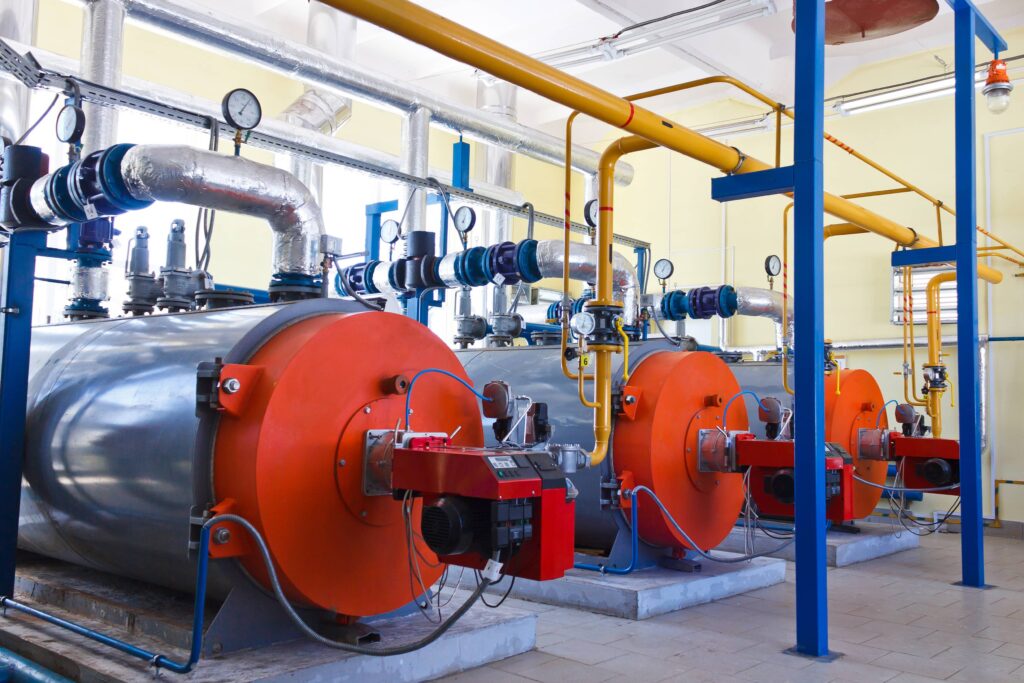In the first article in this series about how boilers in power plants are used for power generation, we looked at their combustion system and how they extract stored energy from a fuel source. In this article, we will take a closer look at their core function: boiling water into steam. Boiling water into steam yields the thermodynamic energy that is ultimately used to power the turbines that generate the power.
How Is Steam Used for Power Generation?
The stored energy released from the boiler’s fuel source in the act of combustion is transferred into heat. The heat enters the water, converting it to steam and creating thermodynamic energy. This thermodynamic steam energy then acts as the heat energy source needed to power the massive turbines that create the power.
Types of Boilers in Power Plants
Boilers in power plants are often categorized as either fire-tube boilers or water-tube boilers. This distinction is based on whether it is the generated heat or the water that passes through the tubes. There are many subtypes of boilers in each category used in different industries for various purposes.
Fire-Tube Boilers
Fire-tube boilers have tubes through which the hot gases, or “fire,” created from combustion pass through. The tubes are surrounded by a sealed tank of water, and as the heat passes through the tubes, it heats the water by the process of thermal conduction. Eventually, the water becomes hot enough to boil and converts into steam.
Construction and Working Principle
- Components: Firebox, combustion chamber, tubes, and steam drum.
- Operation: Hot gases from combustion pass through the tubes, heating the surrounding water, which turns into steam.
For more on boiler construction and repairs, visit Boiler Construction and Repairs.
Advantages and Applications
- Advantages: Simple construction, low cost, easy maintenance.
- Applications: Small to medium-scale industries, heating systems.
Water-Tube Boilers
Water-tube boilers use the opposite configuration compared to fire-tube boilers. With water-tube boilers, instead of the hot gases passing through tubes contained within the water, the water instead passes through tubes contained within the hot gases. This allows heat to be transferred by convection or thermal radiation, resulting in the water boiling into steam.
Construction and Working Principle
- Components: Steam drum, water tubes, mud drum, and circulation pump.
- Operation: Water circulates through the tubes, heated by surrounding hot gases, converting it to steam.
Advantages and Applications
- Advantages: Higher efficiency, better heat transfer, and high steam pressure.
- Applications: Power plants, chemical processing industries, refineries.
Learn more about the need for different types of boilers by product or geography at Different Types of Boilers.

Saturated Steam, Superheated Steam, and Supercritical Steam Generation
There are several important terms describing the nature of the steam and how it is generated:
Saturated Steam
Water converts into steam at 212 °F (100°C). Steam naturally rises above the water because it is much less dense than water. In fact, steam is so much less dense than water that a given amount of steam will occupy a space over 1,000 times the volume of the same amount of water. As the liquid water converts into steam and separates, it will remain at the temperature of its boiling point, 212 °F, unless the pressure is increased. When steam is at this equilibrium point with water, it is called saturated steam.
Superheated Steam
Regular, saturated steam can be expanded into even more steam by superheating it. The remaining water droplets that are suspended in saturated steam can themselves become steam. Superheated steam is important because it increases the efficiency of the boiler. In the power generation industry, it serves an additional crucial function: “drying out” the steam. It is important that dry steam is used for power generation because water droplets could damage the power-generating turbines. This makes superheated steam highly efficient for use in steam boilers at power plants.
Supercritical Steam Generation
Another process often used in the production of electricity is subcritical steam generation. Standard boilers function at subcritical levels, defined as less than 3,200 psi. Below the critical level, boiling bubbles will form as the water is converted to steam. Supercritical generation occurs at pressure levels above the critical threshold of 3,200 psi. At this level, the liquid water instantly becomes steam without ever going through the bubbling and boiling phase. For this reason, the term “boiler” is often avoided for supercritical steam generators since true boiling does not occur. An advantage of supercritical steam generation is that it ultimately uses less fuel and releases less greenhouse gas emissions, reducing carbon emissions and making the process more cost-effective and energy-efficient.
Feed Water, Purification, and Preheating
For the performance of the boiler and purity of the steam it yields, it’s important to use feed water that is as pure as possible. If the feed water contains too many suspended solids or dissolved impurities, this can cause corrosion or a buildup of sediment and sludge in the boiler.
If the feedwater is at room temperature or colder, it requires the boiler to work harder to heat the water. This reduces efficiency and wastes fuel. For this reason, it is very common for the feed water to be preheated before it enters the boiler.
Preheating is often accomplished by outfitting the boiler with an economizer. An economizer is a set of water-filled coils located at the boiler’s stack where the hot gases pass. The economizer captures the heat from these hot gases and uses it to warm the water within its coils before feeding it into the drum, thereby preheating the boiler’s feedwater and making the process more efficient.
Additional Considerations
Energy Efficiency and Advanced Technologies Modern boiler technology focuses on maximizing energy efficiency and reducing energy costs. Innovations in boiler technology include the use of highly efficient materials and designs that minimize heat loss and improve overall boiler system performance.
Environmental Impact and Regulations Compliance with environmental regulations is critical for power plants. Boilers that use fossil fuels must manage flue gases and exhaust gases to reduce harmful emissions. Advanced boiler technologies help reduce carbon emissions and improve the environmental footprint of power generation.
Maintenance and Safety Regular maintenance of boiler systems is essential to ensure safe and efficient operation. This includes inspecting and cleaning pipes, managing high-pressure systems, and ensuring that all components function correctly to prevent energy loss and potential hazards.
The conversion of water into steam is the most salient feature of industrial boilers. For power generation, converting steam into water is still only one phase in the process. The final step involves using the thermodynamic energy present in the steam to turn the power-generating turbines.
By understanding the different types of boilers, the processes of steam generation, and the importance of feed water purification and preheating, we can appreciate the critical role boilers play in power generation. Incorporating advanced technologies and adhering to environmental regulations will ensure that boilers operate efficiently and sustainably, reducing energy costs and carbon emissions while maintaining high standards of safety and performance.
More Resources
- GE Vernova – Boiler Systems for Industrial Steam Power Plants: Comprehensive guide on industrial steam power boilers.
- Mitsubishi Power – Boilers: In-depth information on Mitsubishi’s boiler products.
- Thermodyne Boilers – Steam Power Plant: Detailed overview of steam power plants.

